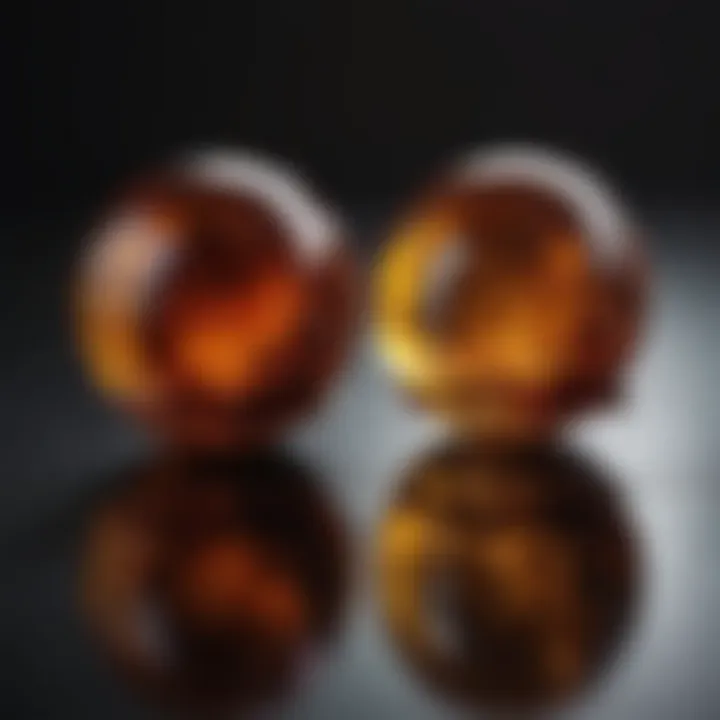Amber in Fragrance: Exploring Its Essence and Influence


Intro
Amber is more than just a beautiful stone; it is a captivating story that spans centuries, cultures, and beauty routines. As one dives into the world of fragrance, amber emerges as a critical player, known for its warmth and complexity. This section serves as a springboard into understanding amber's extraordinary nature and its pivotal role in perfumery.
The allure of amber is not merely skin-deep. Recognized for its rich scent and multifaceted usage, amber has traveled through time—a silent witness to civilization's evolution. Its historical significance, aromatic profiles, and the cultural contexts surrounding it make amber a subject worthy of exploration.
In the following sections, we will peel back the layers of amber, ranging from its sourcing practices to the debate between natural versus synthetic variants. We will also uncover the cultural interpretations and modern applications of amber in the fragrance world. With each aspect, the aim is to enrich our comprehension of this fascinating aromatic compound and to appreciate the secrets it holds.
Prolusion to Amber in Fragrance
Amber's charm has captured human fascination for centuries, reigning as a potent symbol in the realms of fragrance and natural beauty. In this article, we will unfold the layers of amber’s significance—from its defining traits and historical roots, through its emotional impact today. The allure of amber is not merely its rich, warm scent but also the deep connections it forges with various cultures around the world.
Understanding amber’s role in fragrance involves looking at its physical properties, the historical journey it has taken, and the socio-cultural contexts that enhance its appeal. Amber is not merely an ingredient; it is a bridge linking ancient traditions and modern innovations in perfumery, thus intertwining the past and present.
Defining Amber
Amber is often mistaken for a stone, yet it is actually fossilized tree resin. With origins that stretch back millions of years, it embodies a unique collection of organic compounds that dance together to create its distinct scent profile. The color can range from golden yellows to deep browns, and its texture can vary from smooth to rough, often encapsulating ancient inclusions that add to its mystique.
Why is amber so revered in fragrance? Its complex aroma, characterized by warmth and earthiness, has garnered a significant place in perfumer's palettes. This complexity is due to its intricate chemical composition, where notes of vanilla, light spices, and woody undertones intermingle, producing a fragrance that is as comforting as it is captivating.
Historical Context
Amber has been a part of human civilization for a long while. Historical records show that in ancient times, people used amber as both a currency and a tool for making jewelry. The Greeks referred to it as "electron," deriving from the word "ēlektron," which means to shine. Ancient cultures in the Baltic region utilized amber not only for adornment but also for its purported spiritual properties. It was thought to promote healing and protection.
"Amber has woven itself into the very fabric of human history, representing a connection to both the earth and the divine."
In the Middle Ages, amber became coveted across Europe, especially in trade fairs and marketplaces, leading to what some call the "Amber Road"—a trade route that facilitated the exchange of amber. Its historical significance is palpable not just in its economic value but in what it has represented throughout different cultures.
In more recent history, amber has reclaimed its place in perfumery, becoming a staple in many modern fragrances due to its versatile nature and widespread appeal among women and men alike. As we dive deeper into our exploration of amber's fragrant journey, the next sections will reveal its aromatic profile and the modern implications of amber in fragrance.
The Aromatic Profile of Amber
Understanding the aromatic profile of amber is crucial for anyone interested in fragrance, as it forms the backbone of many perfumes and colognes. Amber's scent is often described as warm, rich, and resinous, but its complexity goes far beyond that. This section peels back the layers of amber, revealing its intricate chemistry and the harmonious blend of notes that define its character. A solid grasp of amber's aromatic profile can deepen one's appreciation for its role in perfumery, transforming a casual interest into a passionate pursuit.
Chemical Composition
Amber is not a single entity but rather a blend of various components, each contributing to its unique aroma. Natural amber primarily comprises substances like succinic acid, which is the key player in imparting its characteristic scent. The age and origin of amber can influence its chemical profile significantly. For instance, Baltic amber, dated back millions of years, tends to exhibit a sweeter and more floral scent, whereas Dominican amber can introduce fruity undertones.
Some of the other components that play a part in amber’s fragrance include:
- Phenolic compounds: These are responsible for the resinous notes in amber. They often add depth and complexity to the fragrance.
- Terpenes: They contribute to the citrusy and fresh aspects, brightening the darker, warmer notes.
- Esters: These compounds can lend a sweetness that balances the heavier notes, creating a layered effect.
This intricate balance between natural elements results in an aromatic experience that is both captivating and enticing. The various combinations of these compounds can yield an aromatic profile that is both familiar and exotic.
Fragrance Notes
When diving into the specific fragrance notes of amber, one quickly realizes that its olfactory character is multifaceted. Here, the term "notes" implies the diverse scents that mingle together to form amber's final impression. Typically, amber fragrances are categorized into top, middle, and base notes:
- Top Notes: These are the initial scents that hit the nose upon application. In amber, top notes may include light citrus or herbal nuances, offering a quick burst of freshness.
- Middle Notes: As the top notes evaporate, the heart of the fragrance emerges. Here, you can expect warmer and more complex scents like vanilla and sandalwood, which intertwine with the core amber scent, evoking a sense of coziness.
- Base Notes: Finally, the scent settles into its base notes, which linger the longest. Common examples include rich resins and earthy tones, grounding the fragrance in a warm embrace. This is where amber truly expresses its depth, presenting itself as an opulent yet inviting fragrance that often leaves a lasting impression.
The blend of these different notes in amber can evoke a variety of feelings—reminding some of warm evenings by the fire, while others may think of lush forests imbued with numerous natural essences. Each experience is personal, showcasing amber's versatility across different scent profiles.
Sourcing and Cultivation of Amber
Sourcing and cultivation of amber is a crucial facet in understanding its role both in fragrance and its storied history. This segment not only highlights where amber comes from but also reflects upon the implications of its harvest for both the environment and the economy. Often perceived as a mere ingredient in perfumes, amber’s extraction process involves much careful consideration, ranging from ecological impacts to economic benefits.
Natural Sources
Amber is a natural resin that originates from trees, predominantly conifers, that flourished millions of years ago. Most popular is the ancient amber often sourced in regions like the Baltic Sea or the Dominican Republic. Here, the resin has undergone geological processes, resulting in a beautiful, fossilized form—a process that takes tens of millions of years. The lush forests that existed during the time of the dinosaurs are what produced a good chunk of the amber we admire today. It's like holding a piece of ancient history in your hand.
The extraction of natural amber can be a painstaking endeavor. Harvesters often sift through beach sands that have been weathered over centuries or delve into riverbeds to recover pieces that have washed ashore. This method, while intriguing, comes with its challenges. Environmental concerns arise when extensive mining techniques are employed, causing harm to local ecosystems. Overharvesting can lead to deforestation, which in turn affects wildlife habitats and biodiversity.


In this era, companies are beginning to take steps towards more sustainable practices. For instance, some are investing in eco-friendly mining techniques, aiming to minimize disruption while maximizing yield.
- Key Considerations for Natural Amber Sources:
- Ecological preservation.
- Economic viability for local communities.
- Quality assurance, as purity and clarity affect fragrance quality.
Synthetic Alternatives
The rise of synthetic amber has become increasingly relevant in the fragrance world, especially as consumers become more conscious of sustainability and ethical sourcing. Synthetic amber replicates the scent profile of natural amber while sidestepping some of the environmental costs associated with its harvest. Utilizing laboratory techniques, perfumers can create compounds that mimic amber’s warm, rich aroma, making this a viable alternative.
Companies like Givaudan and Firmenich have developed synthetic materials that can evoke the essence of amber without relying on natural sources. While critics argue that nothing can truly replace the authenticity of natural amber, the advantages of synthetic variants are noteworthy. They provide a consistent quality, are generally more affordable, and often leave a lighter ecological footprint. This is particularly appealing for brands looking to appeal to eco-conscious customers.
"Synthetic options, while debated, can offer a sustainable path forward in fragrance-making, enabling brands to explore new olfactory dimensions without depleting natural resources."
- Benefits of Synthetic Amber:
- More predictable quality and scent profile.
- Lower price point for manufacturers.
- Reduced impact on the environment, depending on sourcing practices.
In essence, the debate continues between natural and synthetic amber. Fragrance connoisseurs may prefer the depth and warmth of natural amber, yet the accessibility and sustainability of synthetic alternatives cannot be overlooked. As our understanding deepens, the market is likely to evolve further, bridging the gap between authentic craftsmanship and modern demands.
Cultural Significance of Amber in Fragrance
The role of amber in fragrance goes beyond just scent; it delves deep into the cultural fabric of various societies throughout history. Understanding the cultural significance of amber enhances one’s appreciation for this unique ingredient, revealing layers of meaning and tradition woven into its use in perfumery. Amber’s multifaceted nature resonates with different communities, reflecting their beliefs, aesthetics, and even their sense of identity.
Amber in Ancient Cultures
Amber has been revered across ancient civilizations, often considered a precious substance shrouded in mystical qualities. The ancient Greeks referred to amber as "electron" and believed it held protective properties. Many would carry amber amulets, aspiring to harness its supposed power against misfortune or illness.
In China, amber was employed not just in fragrances but also featured heavily in traditional medicine. This resin, originating from trees millions of years old, was considered a powerful healing agent. Ancient texts often cite accounts of temperature regulation and circulation enhancement attributed to amber's use.
Moreover, in the Baltic region, where rich deposits of amber are found, it was utilized extensively in trade and was seen as a status symbol. This deep-rooted connection between amber and ancient wealth is still felt in modern Baltic culture, where amber jewelry and artifacts are cherished and passed down through generations.
Amber has been more than just a scent; it's an embodiment of heritage and belief.
Modern Interpretations
In contemporary society, the interpretation of amber has evolved but remains significant. Today, amber holds a dual role; it is both an aromatic base in modern perfumery and a conceptual symbol in art and culture. This shift reflects a broader trend of incorporating natural elements into lifestyle choices, embracing themes of sustainability and authenticity.
Modern perfumers often harness amber in their creations, using it as a warm foundation that adds depth and richness to fragrances. Each brand has its own take on amber, showcasing it in diverse ways, from warm and spicy scents to soft floral blends. This versatility speaks volumes about amber's adaptability and continued relevance in the fragrance industry.
Furthermore, the art community has drawn on the cultural significance of amber, representing it in various forms—be it through pieces of jewelry, art installations, or literature—as a symbol of warmth, creativity, and connection to the earth. The presence of amber reflects a desire to find solace in nature, echoing modern society's quest for meaning amid rapid change and urbanization.
As amber continues to inspire, it is crucial to recognize its rich cultural significance both historically and in today’s world. The fragrance industry, poised between innovation and tradition, will find many ways to honor amber's legacy and utilize its influence in future creations.
Amber in Contemporary Perfumery
Amber has become a cornerstone in the world of contemporary perfumery. Known for its multifaceted scent profile, which balances warm, sweet, and slightly resinous notes, amber's allure extends far beyond its mere fragrance. It evokes a sense of warmth and nostalgia, often associated with comfort and luxury. With the perfume industry racing ahead in creativity and innovation, it's essential to explore how amber fits into the current landscape of scent creation.
The importance of amber in perfumery lies not only in its aromatic contributions but also in its olfactory psychology. Many consumers choose amber-based fragrances for their calming and grounding properties. This effect is particularly appealing in our fast-paced world, where tranquility might feel elusive.
Popular Amber Fragrances
Several fragrances have capitalized on the rich quality of amber, transforming it into a must-have in many perfume collections. Here are some popular choices:
- Tom Ford Amber Absolute: This scent takes boldness to new heights with its warm embrace, combining amber with rich woodsy notes. The result is both sensual and sophisticated.
- Guerlain’s Spiritueuse Double Vanille: A beautiful blend that skillfully marries amber with warm vanilla and spices. Its richness is comforting and inviting.
- Dolce & Gabbana’s Velvet Amber: This one leans into earthy tones, highlighted by the depth of amber. It creates a luxurious aura while maintaining a unique edge against other floral or fruity fragrances.
- Yves Saint Laurent’s Amber Nuit: This fragrance captures the essence of the night with its mysterious and enigmatic qualities. It combines amber with rich spices for an alluring, unforgettable experience.
Each of these fragrances showcases how amber can be masterfully intertwined with various notes to create something truly distinctive, inviting, and emotionally stirring.
Notable Perfumers’ Perspectives
Understanding amber from the perspective of renowned perfumers gives us valuable insight into its impact and versatility. Well-known figures in perfumery have shared their thoughts about the importance and versatility of amber:
- Jean-Claude Ellena, a former in-house perfumer for Hermès, regards amber as a foundation for any fragrance, likening it to a solid canvas that enhances other notes, guiding a perfume's direction without overpowering it.
- Nathalie Lorson, a prominent figure in the industry, emphasizes how amber brings together seemingly disparate elements in a composition. According to her, amber is the glue that holds a fragrance together, allowing fresh notes to beautifully coexist with deeper elements.
- Serge Lutens, a legend in niche perfumery, sees amber as a universal language in scent that communicates feelings of warmth and belonging. He believes that regardless of a person's background, amber ignites shared emotions.


Amber continues to inspire creativity and innovation while being a fundamental part of fragrance blending. The dialogue between amber and its various scent companions illustrates a dynamic interplay that fuels contemporary perfumery, pushing boundaries while connecting with our experiences.
"Amber is not just a fragrance; it's an emotion wrapped in warmth, a sensory biography that tells a story without saying a word."
As such, it's clear that amber's role in contemporary perfumery is far more complex and intricate than merely being a pleasing scent. By embracing its rich history and cultural significance, perfumers can craft scents that resonate deeply with consumers on many levels.
The Role of Amber in Aromatherapy
Amber, often known for its captivating fragrance, takes on a profound role in the field of aromatherapy. This ancient practice utilizes the aromatic properties of natural substances to enhance emotional and physical wellness. Amber, with its rich, warm scent, is more than just a popular note in perfumery; it embodies therapeutic qualities that can influence mood and promote healing.
Therapeutic Properties
In aromatherapy, amber is celebrated for its grounding and calming effects. When inhaled or applied topically, it is believed to promote relaxation and alleviate anxiety. The essence of amber fosters a sense of stability, providing a sanctuary amidst the chaos of daily life. Here are some of amber's notable therapeutic properties:
- Stress Reduction: The warm, resinous aroma is believed to help reduce stress and promote feelings of tranquility.
- Mood Enhancement: Its scent can stimulate feelings of joy and contentment, acting as a natural mood lifter.
- Balancing Energy: Amber is thought to balance emotional energy, helping individuals feel centered.
Beyond emotional wellness, some practitioners also attribute physical benefits to amber. The resin is believed to have anti-inflammatory properties, making it useful in relieving muscle and joint pains. Furthermore, when used regularly, amber is thought to enhance overall vitality.
"The scent of amber is like a warm hug for the soul, wrapping you in comfort and serenity."
Applications in Healing Practices
The applications of amber in healing practices are diverse. From diffusing amber essential oils to using amber-infused products, the versatility of its benefits is remarkable. Below are some common methods and practices:
- Diffusion: Using an essential oil diffuser to disperse amber oil into the air can create a calming environment, perfect for meditation or relaxation.
- Massage Oils: Blending amber essential oil with carrier oils for massages can not only enhance relaxation but also address muscular tension and stiffness.
- Baths: Adding amber oil to bathwater transforms a simple soak into a deeply therapeutic experience, promoting both relaxation and improved skin health.
- Meditative Practices: Incorporating amber in meditation sessions can help practitioners focus on breathing and mindfulness, enhancing the overall experience.
- Aromatic Jewelry: Wearing amber-infused jewelry allows the wearer to benefit from its aroma throughout the day, reinforcing emotional stability and comfort.
In sum, the role of amber in aromatherapy transcends beyond a mere fragrance and penetrates into realms of healing and wellness. By tapping into the soothing power of amber, individuals can cultivate a harmonious environment that nurtures both body and mind.
Comparison of Natural and Synthetic Amber
When exploring the world of amber, it’s vital to understand the differences between natural and synthetic amber. This distinction not only influences the scent and character of fragrances, but also shapes consumer preferences and market dynamics. Knowing these elements will provide clarity to both fragrance aficionados and casual fans.
Benefits and Drawbacks
Natural amber, harvested from ancient trees, offers a unique character that synthetic alternatives often struggle to replicate.
Benefits of Natural Amber:
- Authentic Scent: Natural amber exudes a rich and complex aroma, often described as warm, resinous, and slightly sweet. This authenticity can’t be fully mimicked.
- Cultural Value: Natural amber carries historical significance and cultural narratives, valued for its ancient origins.
- Unique Variations: Each piece of natural amber can present its distinct profile, adding to its allure.
Drawbacks of Natural Amber:
- Cost: Quality natural amber can command high prices, influenced by its rarity and the labor involved in sourcing.
- Environmental Impact: The extraction processes for natural amber can sometimes lead to ecological disturbances, raising sustainability concerns.
On the flip side, synthetic amber provides its own set of advantages and disadvantages.
Benefits of Synthetic Amber:
- Affordability: Typically, synthetic options are cheaper to produce and purchase, making them accessible to a wider audience.
- Consistency in Quality: Synthetic amber offers a stable scent profile that doesn’t vary between batches, ensuring predictability for consumers.
Drawbacks of Synthetic Amber:
- Lack of Depth: While synthetic amber can mimic the aroma, it often falls short of the complexity found in natural variants.
- Cultural Disconnect: Lacking historical context, synthetic amber may not convey the same emotional resonance or cultural connections as its natural counterpart.
Market Trends and Consumer Choices
In recent years, a notable trend has emerged where consumers are increasingly inclined towards natural amber. This shift can be attributed to a growing awareness of sustainability and a preference for authentic ingredients in fragrances. Many enthusiasts believe that natural amber creates a deeper and more personal connection than synthetic options.
"Consumers want to know where their ingredients come from. The allure of natural amber stems not just from its smell but from its presence in our history."
— Fragrance Industry Expert
This inclination has prompted many perfumers to prioritize natural sources, often highlighting the stories behind their creations. Simultaneously, synthetic amber continues to hold its ground in mass-market fragrances due to its affordability and uniformity.
The choice between natural and synthetic amber ultimately comes down to personal preference. Some collectors and connoisseurs will always opt for the genuine article, seeking that authentic experience. Others might favor synthetic products for everyday wear or for budgetary reasons.


The Future of Amber in Fragrance
The ever-evolving landscape of fragrance is a continually shifting paradigm, and amber, with its rich history and profound significance, stands as a nexus of traditional craftsmanship and modern innovation. As we peer into the horizon of fragrance development, it becomes essential to understand how amber will evolve in its role and perception. The future of amber not only beckons new trends but also brings to light pressing considerations particularly regarding sustainability and consumer preferences.
Emerging Trends in Fragrance
Emerging trends in the fragrance industry increasingly lean towards a fusion of classic notes with contemporary practices, and amber distinctly represents this juxtaposition.
- Layering Techniques: Perfumers are exploring amber’s potential through innovative layering. By combining amber oil with other essential oils, perfumers can create complex aromas that add depth and richness. For instance, layering amber with bergamot or cedarwood can yield captivating results that appeal to a modern audience.
- Unisex Fragrances: The paradigm of gender-specific scents is fading. Amber's warmth and sensuality make it an ideal base note for fragrances that appeal to all genders. This shift opens the door to broader marketing strategies and consumer demographics.
- Artisan and Niche Brands: There's a noticeable rise in the popularity of artisan and niche fragrances. These brands often utilize premium amber sourced sustainably, which resonates with an audience that values authenticity in scent. Their emphasis on storytelling and origin addresses a growing desire among consumers to connect with the products they use, fostering a deeper appreciation for amber in fragrance.
The future also anticipates advances in extraction techniques that could yield more purer forms of amber, enhancing its appeal in the perfumer's palette.
Sustainability Concerns
With the growing awareness surrounding environmental issues, sustainability is becoming a crucial consideration in the fragrance industry, particularly with materials like amber that have historical ties to nature.
- Ethical Sourcing: The shift towards ethical sourcing cannot be understated. Consumers are increasingly demanding transparency about where and how amber is harvested. This awareness pushes brands to adopt more sustainable practices, ensuring that they don’t contribute to ecological degradation.
- Synthetic Alternatives: The rise of synthetic amber-like compounds is an intriguing trend that addresses both cost and sustainability. While synthetic alternatives may lack some nuances of natural amber, their ability to reduce environmental impact cannot be ignored. Perfumers are now on a quest to achieve a balance where synthetic options can complement natural amber, creating versatile fragrances that benefit both performances and ethical considerations.
- Consumer Awareness: As consumers become more savvy about their purchases, they tend to gravitate towards brands that prioritize sustainability. This trend is likely to influence how amber is marketed. If consumers can distinguish between sustainably sourced and conventional amber, they may prefer brands that uphold environmental standards, impacting market dynamics.
"The future of amber in fragrance is not just about performance but also about making a positive contribution to our planet’s health."
In summary, the future of amber in fragrance is a tapestry woven with emerging trends focused on innovation, inclusivity, and sustainable practices. As we delve deeper into an era characterized by environmental consciousness, the way amber is perceived and utilized will undoubtedly transform, prompting both creators and consumers to rethink their approaches to scent.
Recognizing Quality Amber Products
When stepping into the world of amber, whether it's for jewelry, fragrance, or collecting purposes, understanding how to recognize quality is essential. Not only does it ensure that you are getting what you pay for, but it also enhances your appreciation for this unique resin. Quality amber products can add significant value and aesthetic appeal, while lower-quality items might leave you feeling like you’ve been sold a bill of goods.
What to Look For
Identifying quality amber involves several key aspects:
- Color: High-quality amber typically showcases a rich, translucent hue. Look for warm shades ranging from golden yellow to deep reddish-brown. If the color appears too uniform or overly bright, it might be an indication of a synthetic product.
- Inclusions: One of amber's alluring features is its birth of ancient inclusions. Bubbles, plant fragments, or even insects trapped within can reveal genuine quality. These inclusions tell a story. If the piece is too clear, it might lead one to doubt its authenticity.
- Weight: Real amber is surprisingly lightweight compared to glass or synthetic materials. When held, it should feel comfortably light, reflecting its natural origin.
- Surface Texture: Quality amber will have a polished yet somewhat warm feel to the touch. If it feels excessively smooth or has a shiny appearance like plastic, approach with caution.
"The beauty of amber is the story it holds within. Look closely, and you may just find a moment in time captured forever."
Avoiding Counterfeits
The market for amber can be riddled with counterfeit products, making it crucial to know how to steer clear of these imitations. Here are some savvy tips to help you navigate the waters:
- Smell Test: Authentic amber has a unique, slightly resinous scent. When heated, it should produce a warm and distinctive aroma. Synthetic alternatives often fail to replicate this olfactory essence.
- Cold Water Test: Real amber will float in saltwater. To check, you can mix about a tablespoon of salt in a cup of water and gently drop in a small piece of suspected amber. If it floats, it’s likely genuine.
- Consult Experts: When in doubt, turning to an expert or a reputable dealer can save you both money and disappointment. Check if the seller has a good reputation, perhaps on forums like reddit.com or through reviews found on platforms such as facebook.com.
- Documentation: Genuine amber, especially higher-quality pieces from reputable sources, often comes with certificates of authenticity. If the deal sounds too good to be true, it likely is.
Finale
As we reach the closing chapter of this exploration of amber in fragrance, it is vital to reflect on the significance of the multifaceted roles that amber plays within the olfactory landscape. This article has illuminated the rich history, diverse applications, and the contrasting nature of natural and synthetic amber while showing how amber's warm, resinous scent resonates across cultures and generations.
The discussions have underscored how amber is not just a mere scent but an experience that encapsulates various emotions and memories. Perfumers have long embraced amber for its ability to ground and enhance compositions, providing depth and warmth that few other materials can match. The rising interest in sustainable practices signifies a need for a more conscientious approach to sourcing amber, ensuring its preservation for future generations.
Key points laid out in this article include vital considerations such as:
- Historical Context: Understanding amber’s journey from ancient civilizations to modern perfumery has provided insight into its enduring popularity.
- Chemical Composition: Recognizing the different chemical components that contribute to amber's unique aroma helps in crafting fragrances that appeal to a wide array of preferences.
- Market Trends: Evaluating the shifts between natural and synthetic alternatives offers a clearer picture of consumer choices in today’s fragrance market.
Amber continues to be a timeless element in fragrance, bridging the old with the new, and serving as a constant reminder of nature's artistry.
The impact of amber is profound, beckoning enthusiasts and casual aficionados alike to appreciate its complex nuances. As we look ahead, the future of amber in fragrance remains vibrant, filled with potential for uplifting olfactory experiences while embracing sustainability and innovation.
Summarizing Key Points
In summary, this exploration has brought to light several key aspects of amber:
- Amber's rich historical significance and its presence in ancient practices.
- The detailed breakdown of its chemical profile enhances our understanding of its aromatic character.
- The sensitivity to sourcing—both natural and synthetic—illustrates the balance needed between demand and ecological responsibility.
- The cultural narratives surrounding amber allow for varying interpretations and uses, showcasing its global relevance.
Each of these points weaves into the fabric of understanding amber not just as a scent, but as a profound element that engages with history, culture, and contemporary trends, making it a cornerstone in the fragrance dialogue.
Future Directions for Research
Looking forward, several avenues beckon for further exploration in the realm of amber and fragrance:
- Sustainable Sourcing: Research into sustainable harvesting methods for natural amber and alternatives will be crucial for ethical fragrance development.
- Chemical Analysis: Delving deeper into the complex chemistry of amber could unveil new uses and formulations that enhance its allure in modern perfumery.
- Cultural Studies: A thorough examination of how different cultures interpret and use amber in rituals and products could yield fascinating insights into its universal appeal.
- Consumer Behavior: There’s a need for more studies addressing consumer preferences between natural and synthetic amber, to better understand market dynamics.
The path forward is rich with possibilities, and the quest to master the use and appreciation of amber within fragrance is unlikely to slow down anytime soon.



